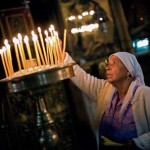
By Elizabeta Koneska With photographs by Robert Jankuloski Issue 2, Winter 2013
Figure 1. Romani woman lighting candles at Manastir Sveta Bogorodica Prečista (Monastery of the Immaculate Holy Mother of God) in Kičevo. Muslim devotees visit the shrine to express their belief in the healing power of the miraculous water from the spring, and their respect for the Holy Mother of God.
Macedonia[1] is a country populated by various ethnic and religious communities with long-standing traditions[2]. Centuries back, these communities lived side by side, and they fostered and practiced their rituals in numerous temples and shrines. It is well known that in Macedonia, both in the past and today, there is a relatively high level of reverence and tolerance for religious shrines from various religious communities and groups. However, it is not as well known that certain shrines, locations, buildings, and moods or feelings associated with particular places in our country have been used by members of different religious and ethnic groups, both Christian and Muslim. The phenomenon of members of different religious and groups visiting, observing, and performing religious rituals in the same shrines is due to two main reasons. The first reason is the belief held by members of different groups that a certain shrine or building in use today belongs to their community and is associated with a patron saint of their particular religion. Similar to this is the belief that, in the past, a Christian temple stood where today a Muslim temple is in use (mosque, tekke, or turbe). The second reason is the belief held by the members of local Muslim communities and groups that certain Christian shrines, or saints associated with the shrines, possess miraculous healing powers.
Independent of the specific reason why these shrines are visited now, local people from the other religious group (to whom the shrines allegedly no longer belong) show a great deal of understanding and respect when visiting the shrines. Several examples of such shrines exist, the most important ones being the Manastir Sveta Bogorodica Prečista (Monastery of the Immaculate Holy Mother of God) near Kičevo, Crkva Sveti Nikola (Church of St. Nicholas) / Turbe H’d’r Baba in Makedonski Brod, the Manastir Sveti Naum (Monastery of St. Naum) near Ohrid, and the Husamedin-Pašina Džamija (Husamedin-Paša Mosque) in Štip. Each of these shrines, as well as the relationship of religious communities and groups toward it, has its own distinguishing characteristics.
Manastir Sveta Bogorodica Prečista stands out among them because its western section, the prothesis, where there is a spring considered to be healing water, is not decorated with frescoes. Therefore, Muslims believe (as well as some Christians) that it was actually intended for them. Crkva Sveti Nikola/Turbe H’d’r Baba has a dual function: in the southwestern part of the temple is the tomb the Muslims believe belongs to the Bektashi saint, H’d’r Baba. Christians, on the other hand, believe that in the past there was a church dedicated to Saint Nikola in the same location. The church in the Manastir Sveti Naum houses the tomb of Saint Naum, which the Muslims believe is the tomb of the Bektashi saint, Sar’ Salt’k. As for the Husamedin-Pašina Džamija in Štip, there is a widespread belief among Christians that, in the same location, there used to be a church dedicated to Saint Ilija (Saint Elijah).
Manastir Sveta Bogorodica Prečista, Kičevo
Manastir Sveta Bogorodica Prečista (Monastery of the Immaculate Holy Mother of God) near Kičevo is considered one of the most significant monasteries in Macedonia. For centuries, it has served as a pivotal center of Slavic literacy in western Macedonia, and has been held in high esteem by both Christians and Muslims.
According to an 1850 chronicle by the abbot of the monastery, Archimandrite Theodosius, a book printed in 1553 in Russia stated that the monastery was founded in 1316. In 1558, the monastery was sacked and burned down, and in 1564 it was rebuilt. The chronicle then records that Saracen raiders destroyed the monastery in 1843, after which it was rebuilt in 1850, for the third time since its founding, on the place where the “self-migrating” icon was found. (Smiljanić 1935: 363–367). This legendary icon currently stands above the spring of water in the narthex. Legends about icons from destroyed monasteries that move on their own to new locations are plentiful in our region. Construction of the monastery was completed not only by the local Kičevo-area population, but also by people from the wider region of western Macedonia. The monastery’s church, which has been there longer than the monastery itself, was erected in 1848. The prothesis has three blind calottes and is not painted on the western side. In the northwestern part of the prothesis is the spring of holy water (Tomovski, Paskali, and Šentevski 1990: 52–56). One of the reasons a part of the prothesis, the narthex, was not painted with frescoes is probably the unstable circumstances and unfavorable economic situation the monastery found itself in during the second part of the 19th century (Tričkovska 1990: 67–95).
Manastir Sveta Bogorodica Prečista near Kičevo is one of the few shrines in Macedonia visited by large numbers of both Christians and Muslims, not only during the festival of the patron saint of the monastery and during the more important church holidays, but also over the course of the year. This Christian church is often visited by Muslims from various ethnic groups, including Macedonian (Slavic) Muslims, Roma, and Albanians. The significant turnout of Muslim devotees is explained by their belief in the healing power of the miraculous water from the spring, and their respect for the Holy Mother of God and for her icon placed on the stone entrance above the spring, through which the worshippers crawl (Belčovski 1990: 134–145).
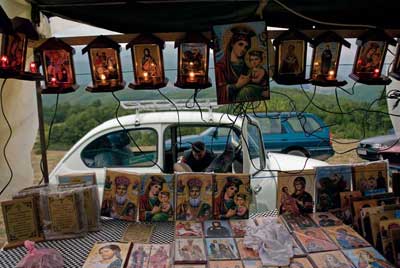
Figure 2. Icons for sale at the fair near the grounds of Manastir Sveta Bogorodica Prečista. The church is one of the few shrines in Macedonia visited by large numbers of both Christians and Muslims, not only during the festival of the patron saint of the monastery and during the more important church holidays, but also over the course of the year.
The monastery’s festival day is Mala Bogorodica (Festival of the Birth of the Holy Mother of God), September 21. Observance of the festival starts the day before, on September 20, and from the afternoon until late into the night on that day, devotees, who are mostly from the town of Kičevo and neighboring villages, begin to gather. Others come from as far as Prilep, Bitola, Ohrid, Resen, Gostivar, Tetovo, and Debar, and some of the devotees attending spend the night at the monastery. In the evening hours there is a liturgy officiated by the bishop of the territorial diocese, who is assisted by several priests from Kičevo and the Ohrid bishopric. The number of worshippers at this stage amounts to several thousand people, including a significantly large number of young people who attend the festival for entertainment and socializing. During the morning hours of the next day, September 21, people arrive again in great numbers, though to a lesser degree than the night before. The bishop and several priests officiate at a morning liturgy. During this ceremony, the new “godfather” (kum) of the monastery is chosen, a volunteer who will help the nuns prepare for the festival the following year. During the monastery’s festival days, a fair also is held in the immediate vicinity of the site.3
On the night of September 20, Muslims, mainly from Romany families plus a few Albanians, are present at the festivities. All Muslims interviewed emphasized that they had come to pay their respects to the Holy Mother of God, and to the shrine, in order to ensure good health for their families. Most of them express the opinion that God is one and the same for all, and that all holy places, such as this one dedicated to the Holy Mother of God, deserve respect and reverence, and that it can only help to visit, no matter which religious denomination an individual belongs to. Some of these people visit the monastery several times a year.
The ritual practices the Muslims perform at the monastery are almost the same as the ones practiced by the Christians. These include walking around the church bearing kurbani [sacrificial gifts], candle lighting, bowing before the iconostasis and praying, crawling through the entrance below the icon of the Holy Mother of God (usually three times), washing with and drinking the holy water from the spring below the stone on the northwestern corner of the prothesis, tossing coins into the spring and water vessels, saying the rosaries (usually three times), leaving gifts, and performing various chores for the monastery.
The phenomenon of a massive Muslim turnout at the monastery in this specific fashion is reflected in the words of the abbess of the monastery, Angija, who speaks very openly about Muslims visiting the shrine. She says that at the beginning of her residence there, during the first half of the 1990s, she could not imagine that Muslims would ever have reason to visit a monastery. After a while, Sister Angija completely changed her stance, saying that if they keep coming it must be because the Mother of God allows it. Today, she even highlights the Muslims’ contribution to the maintenance and upkeep of the monastery.
The Christians generally show a great deal of understanding of and tolerance toward the presence of Muslims at the shrine. There is a widespread belief among ordinary devotees that the western part of the church was actually built for and belongs to the Muslims.
This faith in the miraculous healing power of the icon and holy water, as well as of the shrine itself, has been deeply ingrained in local lore and legends related to the monastery; numerous stories about miracles performed are told even today. The passing down and spreading of these legends and miracles are the main driving force that motivates the Muslims to demonstrate their special respect for the shrine and to visit it several times a year. The legends mainly refer to events surrounding the story of how the location for the monastery was chosen and of its construction.
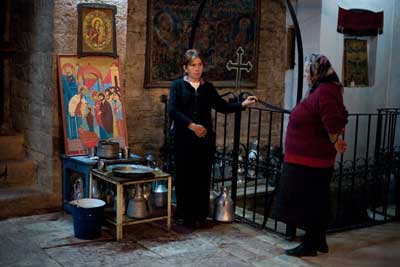
Figure 3. Women standing by the holy water spring in Manastir Sveta Bogorodica Prečista. The “self-migrating,” or “flying,” icon is the large work behind the cross.
The principal legend about the location of the monastery refers to the miraculous icon of the Holy Mother of God, which transported itself three times from the Knežinski Monastery near Kičevo to the present-day location, from where shepherds would always carry it back. Because of this miracle, in time the local residents concluded that a monastery should be erected nearby. However, since the soil was wet and marshy there, they tried to build the monastery near the village of Krnino. But the icon also kept returning from there to the present location, after which they finally decided to erect it where it stands today.
A second group of legends relates to a competition about whose faith is best, held either between a pasha and an abbot or between a master builder and a bey. For the test they used a glass of water that they dropped from a certain height, and every time the outcome of the contest ended up being in favor of the Christian competitor’s faith. There are legends in the Muslim community that assert that the unpainted prothesis is dedicated to them, because, when the Christians decided to build the present-day church and asked the Sultan for a permit, he granted it to them under the condition they build a mosque, too. Therefore, this part of the narthex–prothesis was built especially for the Muslims. Other legends purport that when the temple was about to be built, people could not agree on what kind of temple to construct, so they tossed a coin. The coin landed on its edge, neither heads nor tails, so they built both a church and a mosque.
Examples of miracles performed pertaining to the healing power of the holy water are numerous and refer to both the icon and the ritualistic practice of crawling through the stone entrance below the icon. Miracles chiefly relate to hopes for bearing children, healing mentally ill people, recovery from various physical handicaps, and for relief from other medical conditions. Some miracles are also connected to the punishment of those who steal from the monastery, and so on. Miracles mentioned in connection with the monastery have to do with both Christians and Muslims, since these stories have been disseminated equally among members of both religions.
Crkva Sveti Nikola/H’d’r Baba Tekke, Makedonski Brod
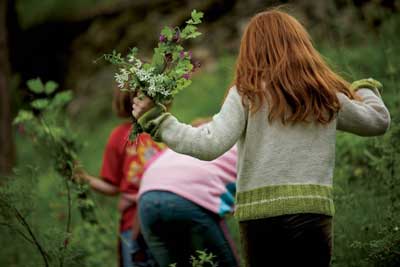
Figure 4. Worshippers who live near Sv. Nikola/H’d’r Baba Tekke in Makedonski Brod collect branches and flowers called “herbs” to decorate the shrine for St. George’s Day in May. People also take the herbs home and decorate their gates, doorways, cradles, pillows, outbuildings, cattle, and barns
The shrine of Sveti Nikola/H’d’r Baba Tekke in Makedonski Brod is a special example of a religious shrine shared by both Christians and Muslims. The Christians believe that the shrine was originally built as a church of Saint Nikola and, after the arrival of the Ottoman Turks, was converted into a tekke, whereas the Muslims believe the shrine was founded as a tekke by the mythical Bektashi saint, H’d’r Baba.
There are no verifiable sources that confirm the existence of a church of Saint Nikola on the location of the shrine before the arrival of the Ottoman Turks. This belief is founded solely in legend. Referring to the collective memory of the local population, Jovanović (1935) states that in the wake of the Ottoman conquests, a number of towns, churches, villages, and cemeteries were sacked, and private property and even whole villages were seized. One village that became the fief of an Ottoman overlord was Brod, whose monastery was first captured by the Ottomans and converted into a tekke, after which the village itself was taken over. The author states that, at the time of his research in 1926, there was a Turkish tekke in Brod (Jovanović 1935: 309–310). Snegarov (1932) mentions “. . . a church of St. Elijah near the village of Brod (Poreče) that was torn down and turned into atekke, most likely during the Islamization of the villages of [the] Dolno Kičevo [area]” (450).
The oldest tale, which is a legend concerning the existence of a church of Sv. Nikola before the Ottoman conquests on these territories, was recorded by Cepenkov in the second half of the last century (Cepenkov 1972: 179–180), who mentions a monastery of Sv. Nikola that was converted into a tekke after the arrival of the Ottomans.4
The oldest written record is cited by Stojanovski, who quotes a census record from 1544 written in Ottoman Turkish. According to him, this historical document confirms the tale recorded by Cepenkov: “Zavie Hizir Baba, also known as Nikola Baba. Saidzavie was founded by a dervish known as Hizir Baba, near the village of Brod.” The fact that in this document the tekke/zavie of Hizir Baba (H’d’r Baba) is also listed as Nikola Baba further suggests the possibility that it was built on the place of an older church of Saint Nikola. Stojanovski states that, up to 1918 there was a tekke in Makedonski Brod, and that in its place in 1979 (when the text was written) only the turbe [tomb or mausoleum] was still visible. Local lore has it that the founder of the tekke,Haydar Baba, is buried there (Stojanovski 1979: 53–57).
What is certain about the shrine is that after the Ottomans arrived, they built the tekke of H’d’r Baba on the place of today’s shrine in the first half of the 16th century. The tekke most likely functioned as an active shrine until World War I, but it is not clear when it was turned into a church. One 1939 land-grant document for the construction of a parochial building records that the designated plot of land is located adjacent to a sanctuary listed as the “kapela Sv. Nikola” (chapel of Saint Nicholas). After the war, the temple fell into ruin and neglect, like many other religious buildings in our lands. Both Christians and Muslims strongly identify with this shrine, a fact borne out by the many legends about its founding. Since each community associates it with a saint from its own religion, it is venerated and visited by the members of both communities. If, per Stojanovski, we can deduce that in 1979 only the turbe remained, then it follows that at the beginning of the 1980s the shrine had still not been converted into the present-day Crkva Sveti Nikola. Facts about the immediate past of the shrine are difficult to glean from the local population, except for the fact that to this day many locals still call it a “turbe” or “tulbe.” The moment when the turbe was converted into a church can only be approximately determined, but most likely it happened by the end of the 1980s or the beginning of the 1990s. In 1994, the local bishop’s consecration of the facility took place, so it could have happened then.
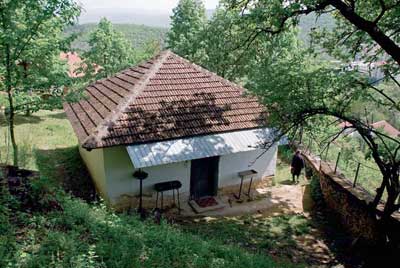
Figure 5. The shrine of Sv. Nikola/H’d’r Baba Tekke has a square form and is modest in size.
The Crkva Sveti Nikola has a square form. On the east side is a small, semicircular apse, which was obviously painted later. The roof of the apse distinguishes itself from the roof of the temple as a whole. It is made from ceramic tiles and slates and has pronounced eaves supported by trimmed wooden consoles. This decorative architectural design is a feature of the architecture of 19th-century Islamic temples. On the south side, the temple has one extended rectangular window with iron grilles, and on the west side there is a small entrance into the temple. In the southwestern part is the tomb, according to the Muslims, of the Bektashi saint, H’d’r Baba. The interior of the church is very modestly adorned with a simple iconostasis and icons painted about ten years ago. The floor, made from flagstones, is coveredwith carpets and rugs. This is so because the shrine serves both as a church and a turbe. Carpets are placed around the tomb featuring Muslim designs (depictions of the saints Ali and Husein, as well as prayer rugs). Pictures of Bektashi saints are also hung on the west and south walls.
This film, Peace for All: St. George’s Day at a Shared Multi-Religious Shrine in Macedonia, by Elizabeta Koneska, shows Muslim and Christian rituals at Sveti Nikola/H’d’r Baba Tekke, including a celebration at the Shrine of Sveti Nikola/H’d’r Baba Tekke. This video ethnography documents the activities at the shared shrine of Sveti Nikola in Makedonski Brod on St. George’s Day. The shrine is shared by Orthodox Christians and various Muslim denominations to celebrate the birth of their respective saints, St. George and H’d’r Baba (Koneska 2009).
Despite the contradictory interpretations related to the origin of the shrine, they do not keep different religious groups from visiting the shrine throughout the year. The largest turnout is for St. George’s Day, also called H’derlez, on May 6.
The Christian customs and rituals practiced for the observance of St. George’s Day in the Crkva Sveti Nikola begin the day before the holiday itself, during the afternoon of May 5, when the largest number of visitors show up, after which a priest officiates at a holiday liturgy in the evening. Worshippers who live near the shrine collect branches and flowers called “herbs.” People take the herbs home and decorate their gates, doorways, cradles, pillows, outbuildings, cattle, and barns. They also leave the collected plants in several places within the area of the church: on the fresco of Saint Nikola, on the courtyard entrance gates, on the church door, on icons, and most of all on the tomb inside the church. Inside, people light candles and leave money and gifts (red eggs, cooking oil, t-shirts, socks, towels, etc.).
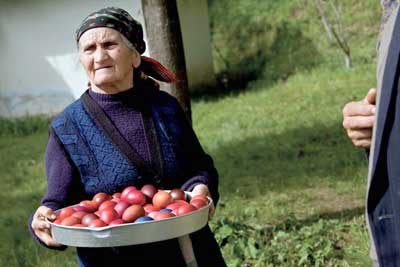
Figure 6. Dragina, the shrine caretaker at Sveti Nikola/H’d’r Baba Tekke, with traditional red-dyed eggs for the St. George’s Day celebration.
The gifts collected throughout the year are sold at an auction in the church courtyard. Those who believe in the healing power of Saint Nikola leave personal items by the tomb of the saint to sit overnight. This is done in the belief that personal wishes will be granted, such as the birth of a child, the curing of a disease, a marriage proposal, and so forth.
On St. George’s Day proper, May 6, the traditional morning liturgy is held in the church. There is a belief that whoever seeks to have a wish fulfilled, especially in the area of marriage, should be the first one to unlock the church in the morning. This is also the day for the celebrated practice of swinging on swings in the courtyard. In the past, primarily young unmarried people would use the swings, and older folks would do so only in jest. During the swinging, ritual songs are sung, mostly lyrical in subject matter, full of symbolism and allegory. The St. George’s Day songs and dances are mostly associated with natural phenomena, and the Macedonian songs are characterized by lyrical themes.
It is interesting to note that the Crkva Sveti Nikola/H’d’r Baba Tekke is covered with carpets and other textiles all year long. The carpets, as well as the Muslim pictures of saints and tapestries that are hung on the walls and around the tomb, are removed on May 5 and 6 and temporarily stored elsewhere. In the evening of May 6 or early on May 7, the custodial personnel of the church replace the rugs and other items (Muslim paintings, photographs, prayer beads, candles, etc.). The majority of visitors who come to celebrate the H’derlez festival in the turbe of H’d’r Baba are members of the Bektashi dervish order from the village of Kanatlartsi, near Prilep, and from the town of Kičevo.

Figure 7. Bektashi ritual during the H’derlez festival in May. The majority of visitors who come to celebrate are members of the Bektashi dervish order from the village of Kanatlartsi, near Prilep, and from the town of Kičevo. On festival days, the turbe is also visited by members of other dervish orders, including the Halveti and Sunni.
On those days, the turbe is also visited by members of other dervish orders, including the Halveti and Sunni. The ritual performed by the Muslims takes place around the tomb of H’d’r Baba with the recitation of various prayers and the leaving of gifts. The water from the vessels inside the temple is used by the worshippers for washing or to take home. A traditional religious custom still performed today, though to a lesser degree than in the past, is one of sitting in the courtyard of the turbe, eating and drinking, and singing spiritual songs.
The fact that this shrine was also used in the past by members of different religious communities can best be illustrated through notes made by the famous 19th-century Macedonian ethnographer, M. Cepenkov: “If someone fell sick at home, his caregiver would take a pitcher of water and place it on the tomb during the night. In the morning, he would retrieve the pitcher and make a small donation to the tekke, in the same manner as if he were making an offering to a monastery; then he would return home and wash the invalid with the water in hopes that Saint Nikola would restore the sick man’s health” (Cepenkov 1972: 180).
Research on the H’derlez or St. George’s Day festival at the shrine of Sveti Nikola/Turbe H’d’r Baba reveals that Christians observe the festival collectively, whereas Muslims do so individually.
There are several legends about the founding of the shrine that are ingrained in local lore of both the Christian and the Muslim populations of Makedonski Brod and beyond. These legends refer to the miracle-working feats of Saint Nikola in connection with the building of the church, or to H’d’r Baba and the founding of thetekke. Aside from legends about the founding of the shrine, there are others, related directly to those saints or to the shrine itself, concerning various miracles having to do with healing and other supernatural powers.
This shrine represents an extraordinary and landmark example as proof that in these areas a model of cohabitation and tolerance for different ethnic and religious groups is a centuries-old tradition still alive today.
Manastir Sveti Naum, Ohrid
Manastir Sveti Naum (Monastery of Saint Naum) is located on the south shore of Lake Ohrid, near the Macedonian–Albanian border. As a center of Orthodox spirituality and Slavic literacy, it has maintained an extraordinary importance for the region since its founding in the 10th century. An important place within the confines of the monastery is the tomb of Saint Naum, where devotees from all across the Balkans and beyond have come to worship the saint and pay their respects for more than a thousand years. Throughout this long period, belief in the healing powers of this Saint Naum has been expressed not only by the Christians, but also by the many Muslims who come to pay homage to his tomb.
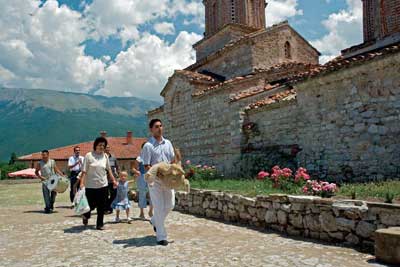
Figure 8. The offering of kurbani, or sacrificial gifts, at Sv. Naum on Lake Ohrid is one of the most distinctive ritual practices of both Muslim and Christian believers at the Feast Day of Sv. Naum on July 3. The sacrificial killing itself is not carried out on monastery grounds, just the ritual procession around the church, which is accompanied by musicians, who are mainly Roma.
The present-day church of Sveti Naum was erected on the foundation of the Crkva Sveti Arhangeli (Church of the Holy Archangels), which Saint Naum had built around AD 900. Over the course of centuries, many changes have taken place, including a complete tearing down and rebuilding of the church. The fresco in the church was painted in 1806, and the fresco in the chapel containing the tomb of Saint Naum dates back to 1800. The three thematic units of the chapel fresco feature the life and miracles of Saint Naum (Grozdanov 2004: 8, 69). The massive turnout of Muslim visitors at this shrine, and especially at the tomb of Saint Naum, is due to their belief that in the painting entitled “Saint Naum Reins in a Bear Instead of an Ox,” the face of Saint Naum actually belongs to the Bektashi saint Sar’ Salt’k. The Bektashi believe that the harness also contains a lion and a deer, and that the tomb in itself belongs to their saint Sar’ Salt’k (Ibrahimgil 2001: 375–389).
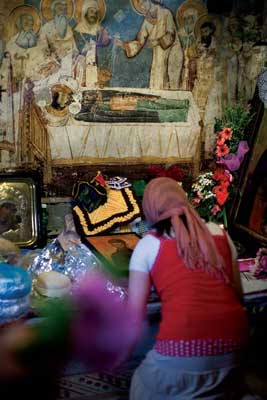
Figure 9. Inside the church, visitors leave money and gifts, and each visitor seeks to bow before the tomb of Saint Naum. The ritual includes kneeling in front of the tomb, placing the head on the tomb, and asking for a wish to be granted.
The extraordinary popularity and large number of visitors at this shrine over the course of the whole year, especially on the Feast Day of Saint Naum (July 3), is due to the Christians’ unwavering faith in the miraculous and healing power of Saint Naum, which is also the same feature that the Muslims attribute to the Bektashi saint, Sar’ Salt’k.
Scholars write that one of the cult places of the Bektashi saint, Sar’ Salt’k is the Manastir Sveti Naum. Aleksiev states that the legends about Sar’ Salt’k describe a legendary figure very similar to the mythical immortal, H’z’r. Salt’k bore his name, performed the same miracles, appeared in the form of a Christian saint, and assisted Muslim armies in battle. The figure of Salt’k represents a synthesis of already established models: he is a holy dervish miracle-worker, an Islamic warrior (gazi), and an epic hero. His cult was not specifically associated with one location, and he appears in many places throughout the Balkans, such as Sveti Naum, where the aforementioned fresco in the chapel, according to the legend, represents this very Sar’ Salt’k. Thus, Muslims visit this monastery and bow before the tomb of Saint Naum believing that it is the tomb of Sar’ Salt’k. (Aleksiev 2000: 37–40).
Ibrahimgil writes that, for the peoples of the Balkans, the relationship they have toward Islam is to a large extent connected to Sar’ Salt’k. According to some, Sar’ Salt’k moved with more than 700 Ottoman families to the Balkans to carry out his missionary work. This is not confirmed by any written document, but instead only through local lore, narratives, and turbes. In the Balkans, Sar’ Salt’k is known not only as a historical and theological figure, but also as a legendary hero. According to legend, as a result of Sar’ Salt’k’s successful conquests in the 13th century, a dervish tekke was founded on the place of today’s monastery, Sveti Naum. However, aside from the tomb, there is no other material evidence proving that this is a tekke of Sar’ Salt’k. Yet, the fresco above the tomb, according to the interpretation of many authors, depicts a Bektashi dervish with a conical hat. The two-wheeled chariot in which the Bektashi dervish sits is pulled by a deer and a lion, which are traditional Bektashi animal symbols. Thus, it is assumed that this place is one of Sar’ Salt’k’s tombs (Ibrahimgil, 2001: 380).

Figure 10. During the festival, visitors camp out on the shore of Lake Ohrid, near the crystal clear springs feeding the Crni Drim River, and in other open areas on the monastery grounds.
The Manastir Sveti Naum observes its festival on July 3, with the celebration beginning the day before. The holiday is attended many people from different religious and ethnic communities from various parts of Macedonia. Believers arrive on July 2 to spend the night at the monastery. They scatter throughout the whole monastery property, mainly along the lakeshore, close to the Crni Drim River, as well as in the park-like areas along the springs and near the “little chapel,” that is, the holy well of Saint Petka. A large number of the visitors are Muslim Roma. Some of them speak Macedonian, others Turkish (from East Macedonia), and still others Albanian (from Struga).
Along with the usual festive evening activities on July 2 and the morning liturgy on July 3, other ritual practices are carried out in the broader monastery complex. In the courtyard of the church, visitors process around the church with a sacrificial gift, and light candles in front of the church.
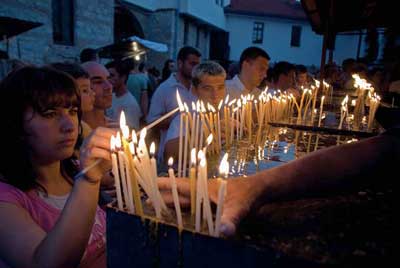
Figure 11. In addition to the kurban procession around the grounds of the monastery, worshippers show their devotion by lighting candles in front of the church.
Inside the church, visitors leave money and gifts. Each visitor seeks to bow before the tomb of Saint Naum: the ritual includes kneeling in front of the tomb, placing the head on the tomb, and asking for a wish to be granted. Some worshippers spend the night at the monastery, or, at the very least, they sit until midnight by the tomb. This practice is considered the most effective for the successful granting of wishes. The majority of devotees sleep lakeside and in the open spaces of the monastery complex, and bring ritual sacrificial gifts. The most common reasons for giving a sacrificial gift are for the birth of a child, for good health, and for marriage. It is believed that Saint Naum especially helps the mentally and psychologically ill. The offering of sacrificial gifts is one of the most distinctive ritual practices of these believers, both Muslim and Christian. The ritual is accompanied by musicians, who are mainly Roma. It is believed that the animal sacrifice, the kurban, possesses a special power. It is interesting to note that a monk, the Archimandrite Nectarius, states that this practice is not a Christian but rather an Old Testament rite, and that it is tolerated because of the desires of numerous believers. In any case, the sacrificial killing itself is not carried out on monastery grounds, just the ritual procession around the church.
The belief in Saint Naum’s miracle-working and healing power is present in many testimonies of devotees whose specific wishes have come true. As these testimonies become known among other devotees, a deep faith in their truthfulness is intensified. Testimonies mainly refer to wishes granted related to the birth of a child and to the curing of various physical and mental diseases. Since Saint Naum carries the epithets “Miracle Worker” and “Healer,” the most significant part of his cult personality is connected with legends surrounding miracles associated with his name. Many people believe that Saint Naum is an “active,” or “live,” saint. This belief is confirmed by many stories and legends related to contemporary miracles performed by him (Risteski 2005). It is a matter of a living tradition of working miracles that has been practiced broadly by the local Muslim and Christian communities in the Ohrid region and neighboring countries. The fact that legends about this saint have existed for more than 1,000 years, dating from his death at the beginning of the 10th century, further enhance the strength of his cult.
All the folk legends about Saint Naum refer to his miracle-working and healing powers and differ only in subject matter and motif. Bearing in mind that the legends have constituted an important part of the oral tradition practiced for centuries in our lands, note that they are still present in many regions in Macedonia and beyond. Therefore, many legends about Saint Naum have nearly the same narrative structures or motif orientation as those that refer to H’d’r Baba Tekke in Makedonski Brod or to the Manastir Sveta Bogorodica Prečista in Kičevo.
These legends can be divided according to certain motifs that recur in several variants: legends about the construction of the monastery; legends about the blessing of tools and domestic animals; legends related to specific places in the vicinity of the monastery; legends about which religion is better and about how the monastery was not converted into a mosque; legends about the taming of wild animals; and legends about forbidden activities in and around the monastery.
Husamedin-Pašina Džamija, Štip
A somewhat more distinct shared shrine, as compared to the three previously described sanctuaries, is the Husamedin-Pašina Džamija (Mosque of Husamedin-Paša) in Štip. This shrine is venerated both by the Christians and the Muslims in the town. The mosque was built at the beginning of the 16th century. Several authors state that the mosque was probably constructed on the site of an older Christian temple, a church dedicated to Saint Ilija (Saint Elijah). Zirojević (1984) proposes that, at the time of the Ottoman conquest or some time later, the church of Sv. Ilija was torn down and the Husamedin-Pašina Džamija was built in its place. The neighborhood of the holy mosque of the late Husamedin-Paša is listed in the census records of 1570–1573, among the neighborhoods registered in the town of Štip, The mosque was new, and the census record lists the names of the employees working at the mosque (Zirojević 1984: 206).
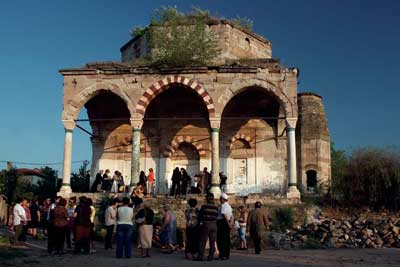
Figure 12. The Mosque of Husamedin-Paša outside the town of Štip is venerated both by the Christians and Muslims. Built in the early 16th century, the mosque is a typical example of the Early Constantinople style of Ottoman sacred architecture. It is speculated that it was built on the site of an older Christian church dedicated to Saint Ilija.
One of the most prominent travel writers of Ottoman times, Evliya Çelebi, writes that, during the second half of the 17th century in the town of Štip there were 24 Muslim shrines, among which he mentions the mosque of Husamedin-Paša. About this shrine, he writes: “. . . an artistically built mosque with a stone minaret. It is covered with lead and sits on the top of a hill.” It is interesting that the author does not mention that the mosque was built on the place where there was a Christian shrine previously, although he states that another mosque in the town of Štip, Fetije Džamija, which at the time of the Ottoman conquest was a church, was later converted into a mosque, to which a mihrab was added (Çelebi 1967: 339–344).
The mosque was active till the end of World War II. In 1953, the building was restored and for a while it served as gallery space for the Štip town museum. After 1956, the edifice did not have any particular function (Pavlov 2005: 170). In recent times, the town’s Christians have visited the mosque to celebrate the festival of Saint Ilija’s Day on August 2.
Husamedin-Pašina Džamija is a typical example of the Early Constantinople style of Ottoman sacred architecture of the early 16th century. The northern side of the mosque is dominated by a simple porch with a three-domed construction and a partially preserved octagonal minaret is on the western side. On the same side in the courtyard is the grave of the sheikh Muyhudin Rumi Baba. The turbe has been completely restored, such that its original construction cannot be determined (Pavlov 2005: 175).
The shrine, called the Husamedin-Pašina Džamija by the Muslims and the Crkva Sveti Ilija (Church of Saint Elijah) by the Christians, is revered equally by both religious groups in the town, and each group claims priority for its use. The representatives of the Islamic religious community in Štip, as well as local Muslims, consider the mosque their holy place of worship, arguing that the edifice possesses all the necessary features of any mosque. The Muslims of Štip are predominantly followers of the Halveti dervish order; they attend mosque and also practice Sunni rituals. Most of them declare themselves to be Turks and they speak Turkish among themselves. However, members of the other ethnic and religious groups in the town (Macedonians, Turks, and Albanians) call them Roma. These Muslims visit the tomb of Medin Baba several times a year and perform the prescribed ritual practices. The turbe is also visited by members of other religious groups, including Sunni Muslims and followers of other dervish orders, as well as some Christians. In 2006 the Muslims in the town reopened the mosque and began to hold religious services there. The Muslims’ position regarding the right to use the shrine is best expressed by the local mullah of the only active mosque in Štip, who claims resolutely that the shrine belongs to the Islamic religious community and that it should be used exclusively by Muslims. He believes that the Christians in the town already have enough religious temples, and that they can observe Saint Ilija’s Day at one of these other places. However, he is also willing to concede that the Christians could observe the festival of Saint Ilija in the mosque’s courtyard if it means so much to them. Despite this view, some of the local Muslims call the mosque and the whole tract of land it is situated on “Sveti Ilija.”
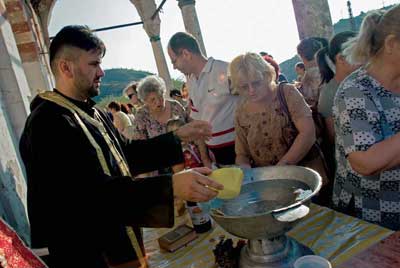
Figure 13. The observance of Saint Ilija’s Day in 2007 took place on the porch in front of the entrance to the mosque. Various wooden props, candleholders, and other items (icons, censers, baptismal fonts, etc.) were brought in from another church. Clergymen conducted their rituals in this improvised ambience, and worshippers lighted candles before the icons and brought gifts.
The Christians in Štip visit this shrine once a year, just to observe of the Festival of Saint Ilija. Until 2006, rituals were performed inside the mosque. The majority of worshippers present at the Festival of Saint Ilija in 2006 and 2007 confirmed that the shrine had been used for decades for the observance of the holiday; however, there were different opinions as to when the rituals began to be enacted inside the mosque. Some believed that the practice dated back to the period between the two World Wars, others claimed it started in the aftermath of WWII, and a third group of people said that it all started at the beginning of the 1990s. The observance of Saint Ilija’s Day in the shrine stems from the belief that the shrine actually is the Crkva Sveti Ilija, despite the obvious fact that the building is a mosque. Some current worshipers believe the shrine in the past was only a small church (of Saint Ilija) and that after the arrival of the Ottomans, it was converted into a mosque. Another view is that a completely new mosque was built on the same location, and after the Turks left these areas, the shrine was reconverted into a church.
During the afternoon of August 1, the observance of Saint Ilija’s Day at the Husamedin-Pašina Džamija begins with the arrival of the worshippers from various parts of town but mostly from the immediate vicinity of the shrine. The observance of the holiday in 2007 took place on the porch in front of the entrance to the mosque. Various wooden props, candleholders, and other items (icons, censers, baptismal fonts, etc.) were brought in from another church. Clergymen conducted their rituals in this improvised ambience, and worshippers lighted candles before the icons, crossed themselves, and brought gifts. On the second day, August 2, festival observances resumed, but with a much smaller crowd.
The Christian believers present at the 2006 and 2007 festivals interpreted the issue of who has the right to use the shrine in different ways. Some thought that a new church should be built in the same location because the existing facility is very much damaged and deformed, and therefore does not resemble a church at all. Others thought that the best solution for the shrine would be to restore the existing mosque and use it as a museum. The majority of them suggested that the shrine should continue to be used by all, and that a common solution that would suit all the town’s residents could be reached in the spirit of tolerance.
Conclusion
Shrines used by members of different religious communities are quite common throughout Macedonia. Most of them are located in western Macedonia, because of its highly ethnically and religiously mixed population. The centuries-old tradition of sharing the same shrines on Macedonian soil in practice refutes the superficial belief in the exclusive nature of ethnic identity and the inevitable separateness of religious communities. On the contrary, these shrines, as well as other similar examples throughout Macedonia, assert the existence of a culture of interethnic and intercultural cohabitation in the best possible manner, and reflect the cherishing of mutual, civilization-based values created through centuries on these territories.
Definitions
bey: an Ottoman lord or provincial governer
calottes: concave, dome-shaped indentations
mihrab: a prayer niche in the wall facing Mecca
narthex: a vestibule leading to the main part of the church
prothesis: in an Eastern Orthodox church, the part of a sanctuary where bread and wine are prepared
tekke: a lodge for Sufi dervishes
turbe: Macedonian турбе: tomb or mausoleum
zavie: small religious cloister
Selected Bibliograaphy
Aleksiev, B. 2001. Za teketata, posveteni na Saru Saltuk Dede [On Tekkes Dedicated to Saru Saltuk Dede]. In Kulturnite vzaimodeistvija na Balkanite i turskata arhitektura: Sbornik od dokladi 1 [Cultural Interactions of the Balkans and Turkish Architecture]. Ankara: Visš institut “Atatürk.” 37–42.
Belčovski, D. 1990. Sveta Bogorodica vo svetlinata na svetoto otkrovenie, pravoslavnoto bogoslovie i kultot [Monastery of the Immaculate Holy Mother in Light of Its Holy Revelation, Orthodox Theology, and Cult. In Manastir Sveta Prečista Kičevska [Kičevo Monastery of the Immaculate Holy Mother of God]. C. Grozdanov (ed.). Skopje: Eparhija Debarsko-Kičevska, Republički zavod za zaštita na spomenicite na kulturata. 134-145.
Bowman, G. 2009. Identification and Identity Formations Around Shared Shrines in West Bank Palestine and Western Macedonia. In Religions traversées: lieux saints partagés entre chrétiens, musulmans et juifs en Mediteranée. D. Albera and M. Couroucli (eds.). Arles: Actes Sud.
Celakoski, N. 1990. Kon istorijata na Manastirot Prečista [On the History of the Monastery of the Immaculate Mother]. InManastir Sveta Prečista Kičevska. 40–51.
Çelebi, E. 1967. Putopis: Odlomci o jugoslovenskim zemljama [Travel Writings: Passages about the Yugoslav Lands].Sarajevo: Svjetlost.
Cepenkov, M. 1972. Makedonski narodni umotvorbi [Macedonian Folk Creations]. Skopje: Makedonska kniga.
Grozdanov, C. 2004. Sveti Naum Ohridski [Saint Naum of Ohrid].Skopje: Kultura.
Ibrahimgil, M. Z. 2001. Balkanlar’da Sarı Saltuk Türbeleri. InSempoziyum Bildiriler kitabı, Balkanlar’da kültürel ve Türk Mimarisi Uluslararası Sempozyumu Bildirileri 1. Ankara: Atatürk Kültür Merkezi Başkanlığı. 375–390.
Ivanov, J. 1970. Bŭlgarski starini iz Makedonija [Bulgarian Antiquities from Macedonia]. Sofija: Bŭlgarska akademija na naukite.
Jovanović, P. 1935. Poreče: naselja i poreklo stanovništva [Poreče: Settlement and Population Origins]. In Srpski etnografski zbornik 28 [Serbian Ethnographic Anthology]. Beograd: Srpska akademija nauka.
Koneska, Elizabeta. 2006. Dilemi okolu istorijata na crkvata Sv. Nikola ili H’d’r Baba turbeto vo Makedonski Brod [Dillemmas Surroundig the History of the Church of St. Nicholas or H’d’r Baba Mausoleum in Makedonski Brod]. In Glasnik 50(1). Skopje: Institut za nacionalna istorija. 161-168.
Koneska, Elizabeta. 2009. Peace for All: St. George’s Day at a Shared Multi-Religious Shrine in Macedonia. Practical Matters 5. Available at http://practicalmattersjournal.org/issue/5/analyzing-matters/peace-for-all (accessed December 6, 2012).
Ḱornakov, D. 1990. Rezbite vo manastirot Sv. Bogorodica Prečista-Kičevska [Woodcarvings in the Kičevo Monastery of the Immaculate Holy Mother]. In Manastir Sveta Prečista Kičevska. 96–110.
Mikulčić, I. 1996. Srednovekovni gradovi i tvrdini vo Makedonija [Medieval Towns and Fortresses in Macedonia]. Skopje: Makedonska civilizacija.
Netkov, V. 1964. Položba, prirodni uslovi, naselenie, topografski razvitok i tip na gradot Štip [Situation, Natural Conditions, Population, Topographical Development and Patterns of the Town of Štip]. In Zbornik Astibo-Štip I-XX vek [Anthology Astibo-Štip in the 1st through 20th Centuries]. Skopje: “Trudbenik.” 15-20.
Nikolovski, A., K. Balabanov and D. Ḱornakov. 1980. Spomenici na kulturata na Makedonija [Documents Related to the Culture of Macedonia]. Skopje: Misla.
Pavlov, Z. 2005. Husamedin Pašina džamija [Mosque of Husamedin Paša]. In Zaednički rehabilitacionen proekt-plan/procena na arhitektonskoto i arheološkoto nasledstvo na Jugoistočna Evropa (2003–2006) 1 [Collaborative Rehabilitiation Plan/Assessment of the Architectural and Archeological Inhertitance of Southeastern Europe (2003-2006). Skopje: Uprava za zaštita na kulturnoto nasledstvo.
Petković , V. 1950. Pregled crkvenih spomenika kroz povesnicu srpskog naroda [Review of Church Monuments through the History of the Serbian People]. Beograd: Srpska akademija nauka.
Risteski, S. 2005. Čudata na Sveti Naum [The Miracles of Saint Naum]. Ohrid: Makedonska pravoslavna crkva.
Smiljanić, T. 1935. Kičevija: Naselja i poreklo stanovništva [Kičevo Area: Settlement and Population Origin]. In Srpski etnografski zbornik 28 [Serbian Ethnographic Anthology]. Beograd: Srpska akademija nauka.
Snegarov, J. 1932 (1995). Istorija na Ohridskata arhiepiskopija-patrijaršija 2 [History of the Ohrid Archbishopric-Patriarchate].(Photo reprint ed.) Sofija: Izd-vo “Prof. Marin Drinov.”
Stojanovski, A. 1979. Edno potvrdeno predanie [A Confirmed Legend]. In Muzejski glasnik 4 [Museum News]. Skopje: Istoriski muzej na Makedonija. 53-57.
Stojanovski, A. and D. Ǵorǵiev. 2001. Naselbi i naselenie vo Makedonija: 15 i 16 vek [Settlements and Population in Macedonia: 15th and 16th Centuries]. Skopje: Institut za nacionalna istorija, Državen arhiv na R. Makedonija.
Tomovski, K., T. Paskali, and N. Šentevski. 1990. Manastir Sv. Bogorodica Prečista: Arhitektura [Monastery of the Immaculate Holy Mother: Architecture]. In Manastir Sveta Prečista Kičevska.52–66.
Trajčev, G. 1933. Manastirite v Makedonija [Monasteries in Macedonia]. Sofija.
Tričkovska, J. 1990. Živopisot vo manastirskata crkva Bogorodica Prečista-Kičevska [Paintings in the Kičevo Monastery Church of the Holy Mother of God]. In Manastir Sveta Prečista Kičevska.67–95.
Vražinovski, T. 2002. Rečnik na makedonskata narodna mitologija [Dictionary of Macedonian Folk Mythology]. Skopje: Matica Makedonska.
Zirojević, O. 1984. Crkve i manastiri na području Pečke patrijaršije do 1683 godine [Churches and Monasteries in the Area of the Peč Patriarchate until 1683]. Beograd: Istorijski Institut u Beogradu.
Endnotes
This article was originally published in book form by the Macedonian Centre for Photography in 2009. The book,Zaednički svetilišta / Shared Shrines, by Elizabeta Koneska, with photographs by Robert Jankuloski, was published in Macedonian and English, with original translation by Dijana Obradović. Revised translation by Rachel MacFarlane, for Forum Folkloristika.
The study and research of “shared shrines” in Macedonia is inspired by the fact that certain sacred places and buildings are, or have been in the past, shared by devotees belonging to different religious groups and ethnic communities. The current research has been enhanced by participation in the “Inter-Communal Interactions Around ‘Mixed Shrines’ in Macedonia” project, initiated by anthropologist Glenn Bowman from the University of Kent, England, with research carried out in 2005 and 2006. Additional research on the subject was conducted in 2007 independently of that project.
Before 2004, when the fair was held in the courtyard of the monastery, sacrificial gifts (kurbani) were carried around the church accompanied by live music (zurla and tapan); today the procession around the church is silent, with no musical accompaniment.
“In the olden days there was a monastery dedicated to St. Nicholas. After the Turks came to Kičevo, a Turk became a dervish, and he went to the monastery and turned it into atekke. All well and good, but no man stepped inside to bring Ad’r Baba, the dervish, something to eat. Finally, Ad’r Baba built a hut close to the road and sat inside. He placed a donation box there, and whenever a wayfarer passed by on his way in or out of Kičevo, he would tap on a small drum and ask for alms. In this way no one could see what he really looked like. Soon the dervish order started multiplying, but still no man had laid eyes on the old dervish. When it was his turn to die he was buried in the tekke, where his grave still stands, covered with stout green cloth. And thus the Turks came to venerate the tekke of Ad’r Baba, and the Bulgarians the old temple of St. Nicholas ever since it was a monastery.” (Cepenkov 1972: 000)
About the Author
 Elizabeta Koneska is an ethnologist who was born in and lives in Skopje, Macedonia. She studied in Belgrade and in Istanbul. Since 1985 Koneska has worked at the National Museum of Macedonia. Her research interests include coppersmith and tinsmith crafts, traditional food, the Slavic Orthodox community in Istanbul, and Turkish and other Muslim communities in Macedonia. She has researched and directed thirteen ethnological film projects in Macedonia and Turkey. These projects include: The Iron Church Above the Water (1993), The Sound of the Hammer (2000), The Belgrade Coppersmith (2002), and Macedonians in Istanbul (2011). Peace for All has been screened at film festivals and universities in Bulgaria, Turkey, and Great Britain.
Elizabeta Koneska is an ethnologist who was born in and lives in Skopje, Macedonia. She studied in Belgrade and in Istanbul. Since 1985 Koneska has worked at the National Museum of Macedonia. Her research interests include coppersmith and tinsmith crafts, traditional food, the Slavic Orthodox community in Istanbul, and Turkish and other Muslim communities in Macedonia. She has researched and directed thirteen ethnological film projects in Macedonia and Turkey. These projects include: The Iron Church Above the Water (1993), The Sound of the Hammer (2000), The Belgrade Coppersmith (2002), and Macedonians in Istanbul (2011). Peace for All has been screened at film festivals and universities in Bulgaria, Turkey, and Great Britain.
About the Photographer
 Robert Jankuloski, from Prilep, Macedonia, is a photographer and director of the Macedonian Centre for Photography. In 1996 he graduated from the Faculty for Dramatic Arts in Skopje (Camera Department). He is the founder of the Macedonian Centre for Photography. He teaches photography at several programs in Macedonia, and has held 18 solo exhibitions in Macedonia, Bulgaria, Austria, and Serbia.
Robert Jankuloski, from Prilep, Macedonia, is a photographer and director of the Macedonian Centre for Photography. In 1996 he graduated from the Faculty for Dramatic Arts in Skopje (Camera Department). He is the founder of the Macedonian Centre for Photography. He teaches photography at several programs in Macedonia, and has held 18 solo exhibitions in Macedonia, Bulgaria, Austria, and Serbia.
Jankuloski has participated in numerous group exhibitions including Manifesta, European Biennial of Contemporary Art (Luxembourg, 1996) and Context: Europe—Artistic Impulse from Southeastern Europe (Lyon, 2003). He has received many awards for photography and has worked as still photographer and director of photography on several feature and documentary films.
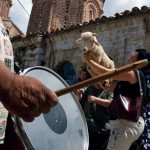













 Elizabeta Koneska is an ethnologist who was born in and lives in Skopje, Macedonia. She studied in Belgrade and in Istanbul. Since 1985 Koneska has worked at the National Museum of Macedonia. Her research interests include coppersmith and tinsmith crafts, traditional food, the Slavic Orthodox community in Istanbul, and Turkish and other Muslim communities in Macedonia. She has researched and directed thirteen ethnological film projects in Macedonia and Turkey. These projects include: The Iron Church Above the Water (1993), The Sound of the Hammer (2000), The Belgrade Coppersmith (2002), and Macedonians in Istanbul (2011). Peace for All has been screened at film festivals and universities in Bulgaria, Turkey, and Great Britain.
Elizabeta Koneska is an ethnologist who was born in and lives in Skopje, Macedonia. She studied in Belgrade and in Istanbul. Since 1985 Koneska has worked at the National Museum of Macedonia. Her research interests include coppersmith and tinsmith crafts, traditional food, the Slavic Orthodox community in Istanbul, and Turkish and other Muslim communities in Macedonia. She has researched and directed thirteen ethnological film projects in Macedonia and Turkey. These projects include: The Iron Church Above the Water (1993), The Sound of the Hammer (2000), The Belgrade Coppersmith (2002), and Macedonians in Istanbul (2011). Peace for All has been screened at film festivals and universities in Bulgaria, Turkey, and Great Britain. Robert Jankuloski, from Prilep, Macedonia, is a photographer and director of the Macedonian Centre for Photography. In 1996 he graduated from the Faculty for Dramatic Arts in Skopje (Camera Department). He is the founder of the Macedonian Centre for Photography. He teaches photography at several programs in Macedonia, and has held 18 solo exhibitions in Macedonia, Bulgaria, Austria, and Serbia.
Robert Jankuloski, from Prilep, Macedonia, is a photographer and director of the Macedonian Centre for Photography. In 1996 he graduated from the Faculty for Dramatic Arts in Skopje (Camera Department). He is the founder of the Macedonian Centre for Photography. He teaches photography at several programs in Macedonia, and has held 18 solo exhibitions in Macedonia, Bulgaria, Austria, and Serbia.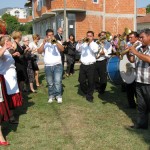
 Alex Marković is a Ph.D. candidate in the Department of Anthropology at the University of Illinois-Chicago. He spent a total of 17 months conducting field research with Romani brass musicians in the Vranje region of southeastern Serbia, working with local Serb and Romani communities and documenting myriad musical celebrations such as weddings. His dissertation looks at ethnicity and identity politics in the context of musical performance, investigating how musical practices shape ideas about—and performances of—Romani (“Gypsy“) identity in society. Alex’s research interests in anthropology and ethnomusicology are focused on the relationships between processes of identity, socioeconomic change, cultural performance, ritual, music, and dance in the Balkans and in Balkan diasporas.
Alex Marković is a Ph.D. candidate in the Department of Anthropology at the University of Illinois-Chicago. He spent a total of 17 months conducting field research with Romani brass musicians in the Vranje region of southeastern Serbia, working with local Serb and Romani communities and documenting myriad musical celebrations such as weddings. His dissertation looks at ethnicity and identity politics in the context of musical performance, investigating how musical practices shape ideas about—and performances of—Romani (“Gypsy“) identity in society. Alex’s research interests in anthropology and ethnomusicology are focused on the relationships between processes of identity, socioeconomic change, cultural performance, ritual, music, and dance in the Balkans and in Balkan diasporas.